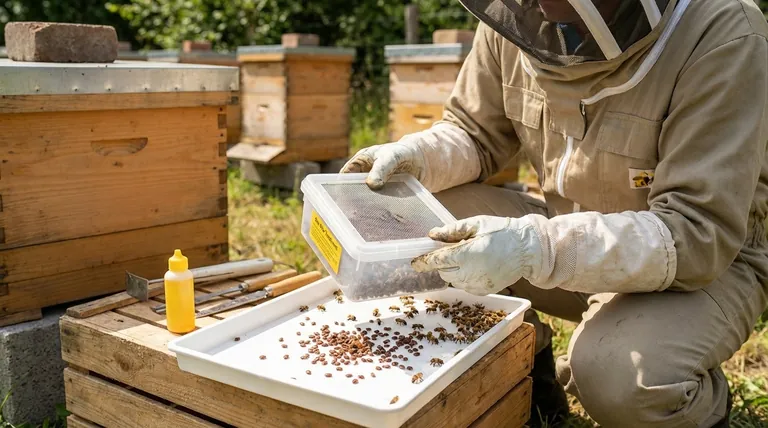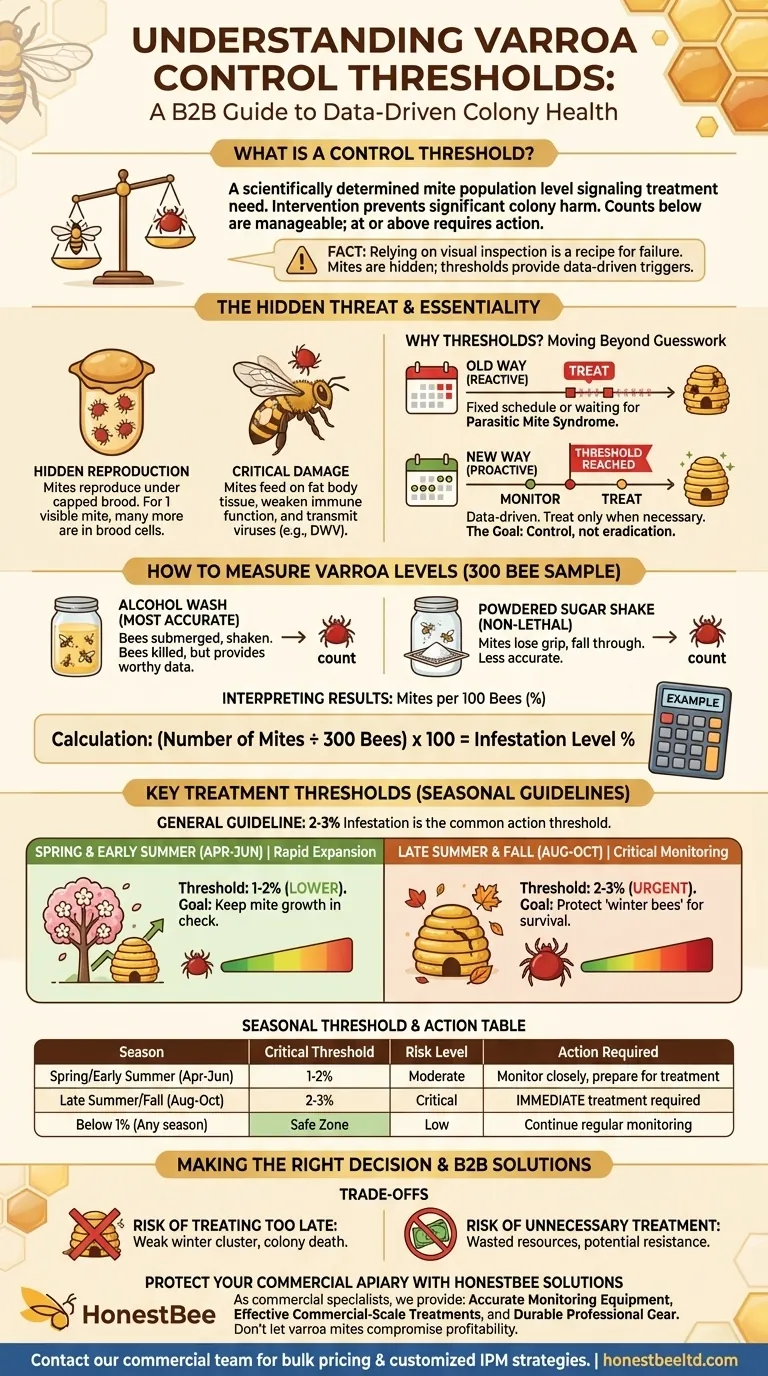In beekeeping, a Varroa control threshold is a scientifically determined mite population level that signals the need for treatment. If your mite count is at or above this level, intervention is required to prevent significant harm to the colony. Counts below the threshold are considered manageable and do not require immediate action.
Relying on a visual inspection for Varroa mites is a recipe for failure, as you will only see mites when the infestation is already severe. Control thresholds provide an objective, data-driven trigger for treatment, empowering you to act before the mite population causes irreversible damage to your bees.

Why Thresholds Are Essential for Colony Health
Varroa mites are the single greatest threat to honey bee health worldwide. They are not just simple parasites; they are vectors for deadly viruses and weaken the colony's immune system. Using thresholds is the foundation of a modern Integrated Pest Management (IPM) strategy for beekeeping.
The Hidden Threat of Varroa
Varroa mites reproduce under the capped brood, hidden from view. For every one mite you might see on an adult bee, there are many more in the brood cells. By the time you can easily spot mites on bees, the infestation is already at a critical, often fatal, level.
These mites feed on the bee's fat body tissue, a vital organ responsible for immune function, detoxification, and energy storage. This feeding weakens the bee and transmits viruses, most notably Deformed Wing Virus (DWV).
Moving Beyond Guesswork
Before the widespread use of thresholds, beekeepers often treated on a fixed calendar schedule or waited until the colony showed visible signs of stress (a condition called Parasitic Mite Syndrome). Thresholds replace this guesswork with data, ensuring you treat only when necessary. This proactive approach is far more effective than reacting to a colony that is already in decline.
The Goal: Control, Not Eradication
The objective is not to eradicate every single mite, which is an impossible task. The goal is to keep the mite population below a level where it can cause significant economic or biological damage to the colony. Thresholds define this "damaging level."
How to Measure Varroa Levels
To use thresholds, you must first get an accurate mite count. This is done by taking a sample of approximately 300 adult bees (about 1/2 cup) and dislodging the mites.
The Alcohol Wash Method
This is the most accurate method. The bee sample is submerged in rubbing alcohol and shaken, which dislodges the mites. The bees are killed, but the data you gain is considered a worthy trade-off for the health of the entire colony.
The Powdered Sugar Shake Method
In this method, powdered sugar is used to coat the bees, causing the mites to lose their grip. The bees and sugar are shaken over a screen, and the mites fall through for counting. This method can release the bees unharmed, but it is generally considered less accurate than an alcohol wash.
Interpreting the Results
Your result is expressed as a percentage, or "mites per 100 bees." To calculate this, divide the number of mites you counted by the number of bees in your sample, then multiply by 100. For a standard 300-bee sample, you simply divide your mite count by 3.
- Example: You count 9 mites in a 300-bee sample.
- Calculation: 9 mites / 300 bees = 0.03.
- Result: 0.03 x 100 = 3% infestation level.
Understanding the Key Treatment Thresholds
While thresholds can vary slightly by region and beekeeping operation, there are widely accepted guidelines based on the time of year. The mite population and the bee population fluctuate seasonally, which changes the level of risk.
The General Guideline: 2-3% Infestation
A mite level of 2-3 mites per 100 bees (a 2-3% infestation) is the most common action threshold. If your monitoring shows a mite level at or above this percentage, it is time to implement a control measure.
Why Thresholds Change With the Season
The most critical factor is the bee population cycle. When the bee population is large, the colony can tolerate a higher number of mites. But as the bee population shrinks in the fall, the same number of mites becomes a much higher—and more dangerous—percentage of the population.
Spring and Early Summer (April-June)
During this period, the bee population is expanding rapidly. The threshold is often kept lower, around 1-2%. The goal is to keep mite growth in check so the population doesn't explode later in the season.
Late Summer and Fall (August-October)
This is the most critical monitoring period. The queen is laying fewer eggs, and the colony's population will soon decline. The mites, however, are reaching their peak population. An infestation level of 2-3% at this time is an urgent signal to treat. This treatment protects the "winter bees" that must survive for months to ensure the colony makes it to spring.
The Trade-offs of Treatment Decisions
Using thresholds is about balancing risk. Every decision, including the decision not to act, has consequences.
The Risk of Treating Too Late (or Not at All)
This is by far the greater risk. Ignoring a high mite count, especially in the fall, will lead to a weakened winter cluster that is highly susceptible to viruses and cold stress. The result is often colony death over the winter or a "dwindling" in early spring.
The Risk of Treating Unnecessarily
Treating when mite levels are very low (e.g., below 1%) exposes the bees to chemical treatments without a clear benefit. This adds stress to the colony, costs the beekeeper time and money, and can contribute to mites developing resistance to treatments over time. This is precisely the problem that thresholds solve.
Making the Right Decision for Your Apiary
Your monitoring results are not just numbers; they are direct instructions from your bees. Use this data to guide your management actions.
- If your monitoring shows a mite level of 1% in early summer: Your colony is in good shape, but continue to be vigilant. Plan to monitor again in 4-6 weeks to track mite population growth.
- If your monitoring shows a mite level of 3% or more in late August: This is a critical situation. You must treat immediately to protect the bees that will form your winter cluster.
- If your mite levels are consistently below 1% without treatment: You may have bees with valuable hygienic traits. Continue to monitor regularly, as mite pressure from neighboring apiaries can change your situation quickly.
By using data-driven thresholds, you transform from a reactive beekeeper into a proactive guardian of your colony's long-term health.
Summary Table:
| Season | Critical Threshold | Risk Level | Action Required |
|---|---|---|---|
| Spring/Early Summer (Apr-Jun) | 1-2% | Moderate | Monitor closely, prepare for treatment |
| Late Summer/Fall (Aug-Oct) | 2-3% | Critical | Immediate treatment required |
| Below 1% (Any season) | Safe Zone | Low | Continue regular monitoring |
Protect Your Commercial Apiary with Professional-Grade Varroa Control Solutions
As a commercial beekeeper or equipment distributor, you understand that varroa mites represent the single greatest threat to colony health and productivity. At HONESTBEE, we supply commercial apiaries and distributors with wholesale-focused beekeeping supplies and equipment designed specifically for large-scale operations.
Our comprehensive varroa management solutions include:
- Accurate monitoring equipment for reliable mite counts
- Effective treatment options suitable for commercial-scale applications
- Durable protective gear and hive tools built for professional use
Don't let varroa mites compromise your operation's profitability. Our team understands the unique challenges faced by commercial beekeepers and can help you implement data-driven IPM strategies that protect your investment.
Contact our commercial solutions team today to discuss bulk pricing and customized varroa control systems for your operation.
Visual Guide

Related Products
- Adjustable Formic and Acetic Acid Dispenser for Bee Mite Treatment
- Australian Pine Wood Langstroth Screen Bottom Board for Wholesale
- Plastic Chinese Queen Grafting Tool for Bee Queen Rearing
- Honey Convey Pump Screw Honey Pump for Viscous Liquid
- Inverted Squeezable Honey Jar with No Drip Flip Top Cap for Easy Pouring
People Also Ask
- What is the optimal time for varroa mite control in nucs? Maximize Efficacy with Perfect Timing
- What should beekeepers do to manage varroa mites effectively? Adopt a Proactive Monitoring Strategy
- What does Chewed Down Brood (CDB) indicate in bee colonies? A Sign of Varroa Mite Infestation
- What are the symptoms of Varroa Mite Syndrome (VMS)? Recognizing the Signs of Colony Collapse
- How can beekeepers ensure their hives survive the winter? A Guide to Colony Survival






